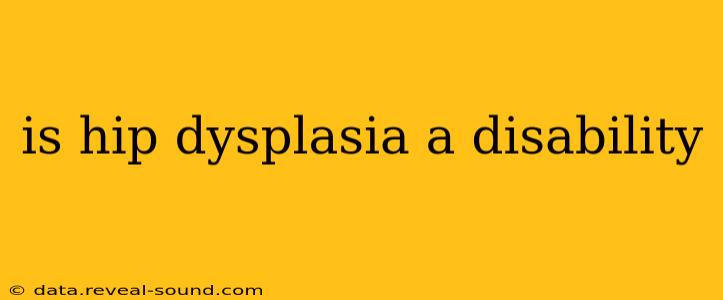Hip dysplasia is a condition where the hip joint doesn't develop properly, leading to instability and potential long-term complications. Whether it's considered a disability depends on several factors, making it a complex question without a simple yes or no answer. This article delves into the intricacies of hip dysplasia, exploring its impact on daily life and the criteria used to determine disability status.
What is Hip Dysplasia?
Hip dysplasia is a developmental condition affecting the hip joint. It's characterized by an abnormal formation of the acetabulum (the socket of the hip joint) and/or the femoral head (the ball of the hip joint). This improper fit can lead to instability, pain, and, if left untreated, significant long-term consequences. The severity of hip dysplasia varies greatly from person to person. Some individuals may experience only mild discomfort, while others face severe limitations in mobility and require extensive treatment.
Can Hip Dysplasia Qualify for Disability Benefits?
The determination of whether hip dysplasia qualifies someone for disability benefits depends heavily on the severity of the condition and its impact on the individual's ability to perform daily activities. Disability programs, such as Social Security Disability Insurance (SSDI) in the United States, assess disability based on specific criteria:
- Severity of symptoms: The intensity of pain, limitations in movement, and frequency of exacerbations all play a critical role. Severe pain that limits walking, standing, sitting, or sleeping significantly would likely be a stronger indicator of disability.
- Functional limitations: The extent to which hip dysplasia interferes with daily activities, such as dressing, bathing, working, and socializing, is crucial. Inability to perform basic tasks independently can significantly influence the disability determination.
- Medical evidence: Thorough medical documentation, including x-rays, physical therapy reports, and physician evaluations, is essential to substantiate the claim. The documentation needs to clearly illustrate the severity and limitations imposed by the condition.
- Age and occupation: An individual's age and previous occupation will influence the assessment. Older individuals with physically demanding past jobs might face more significant challenges returning to work.
What are the Long-Term Effects of Hip Dysplasia?
The long-term effects of hip dysplasia can range from mild discomfort to severe disability. Untreated or severely affected individuals may experience:
- Chronic pain: Persistent pain in the hip, groin, and thigh is a common symptom.
- Reduced mobility: Difficulty walking, climbing stairs, and engaging in physical activities.
- Osteoarthritis: The abnormal joint mechanics can lead to early-onset osteoarthritis, causing further pain and joint degeneration.
- Need for surgery: In severe cases, hip replacement surgery may be necessary to alleviate pain and restore function.
How is Hip Dysplasia Diagnosed?
Diagnosis typically involves a physical examination, including checking for range of motion and stability in the hip joint. Imaging techniques like X-rays and ultrasounds are used to visualize the hip joint and assess the severity of dysplasia.
Can Hip Dysplasia Be Treated?
Treatment options vary depending on the severity of the condition and the individual's age. Treatment may include:
- Physical therapy: To strengthen muscles, improve range of motion, and reduce pain.
- Bracing: In infants and young children, bracing can help guide the hip joint into proper alignment.
- Medication: Pain relievers and anti-inflammatory drugs can help manage pain and inflammation.
- Surgery: In severe cases, surgery may be necessary to repair or replace the hip joint.
Does Hip Dysplasia Always Lead to Disability?
No, hip dysplasia does not always lead to disability. Many individuals with hip dysplasia can manage their condition effectively through conservative treatment, maintaining an active lifestyle with minimal limitations. However, the severity of the condition and its impact on daily activities are crucial factors determining whether it constitutes a disability.
How Does Hip Dysplasia Affect Daily Life?
The impact on daily life varies greatly. Some individuals may experience only mild discomfort and minimal limitations, while others may face significant challenges in mobility, requiring assistance with daily tasks. The impact can affect work, social life, and overall quality of life.
Conclusion
Whether hip dysplasia is considered a disability is a highly individual determination. The severity of the condition, its impact on daily life, and the available treatment options all contribute to the overall assessment. A comprehensive evaluation by healthcare professionals and a thorough understanding of disability criteria are essential to make an accurate determination. If you are experiencing significant limitations due to hip dysplasia, consulting with a physician and exploring disability resources is recommended.
